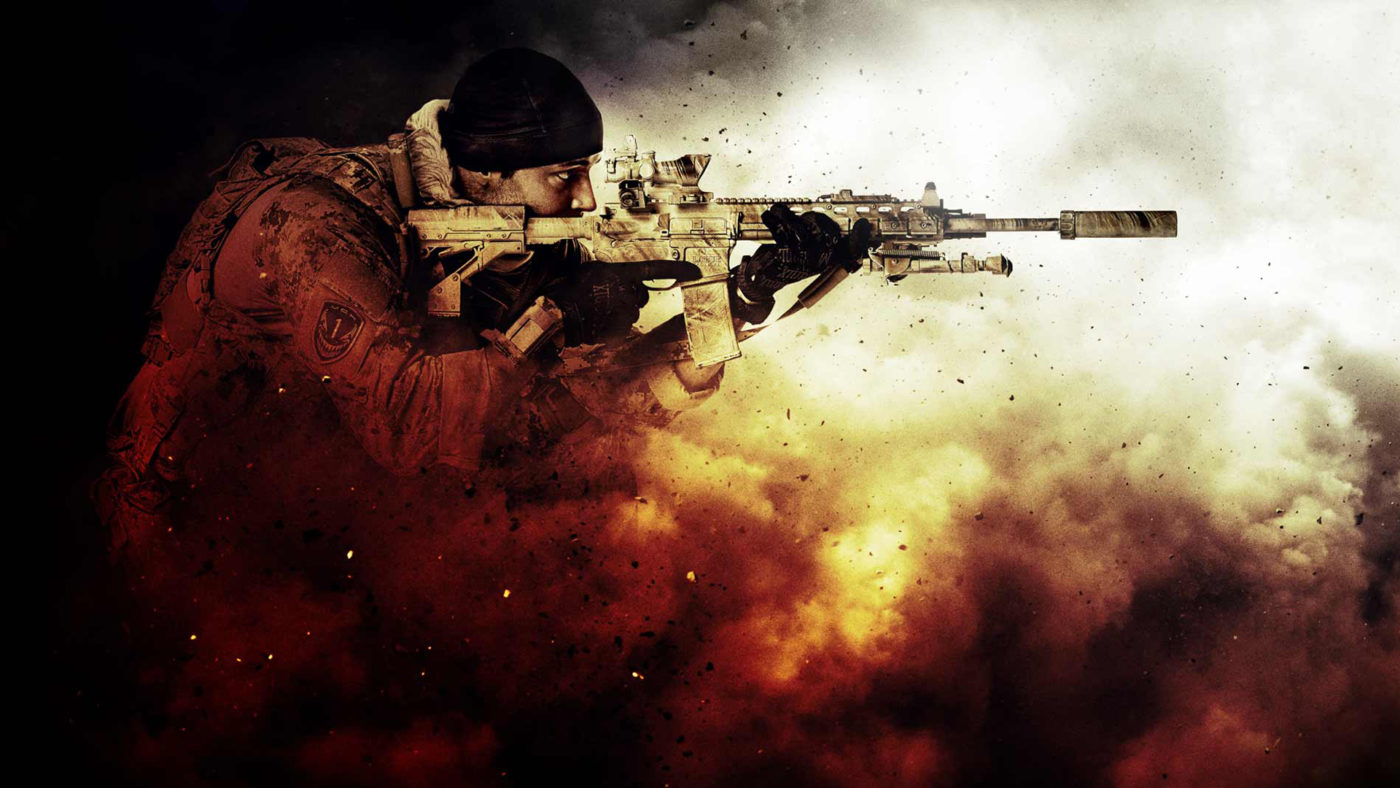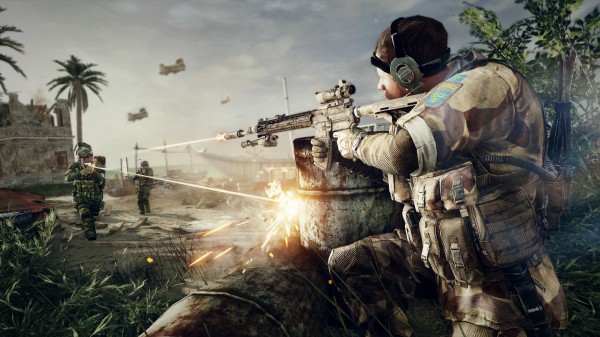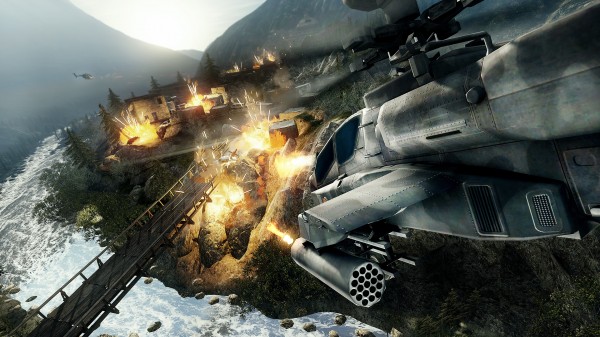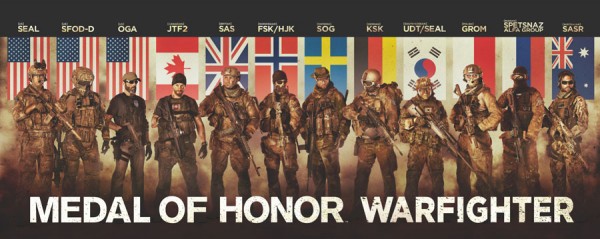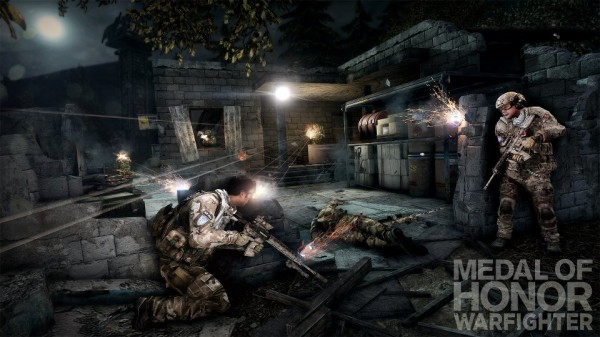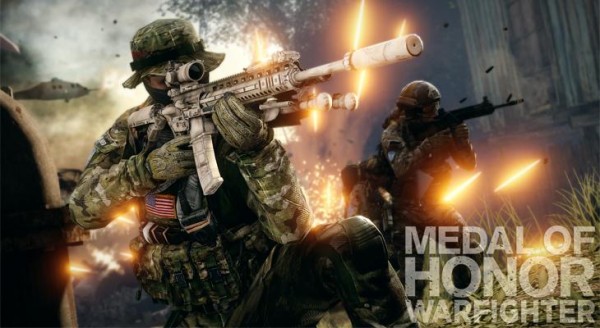Patch Notes
- October 23, 2012 [Day-One Patch]
- October 27, 2012 [Server Update]
- November 2, 2012 [Server Update]
- December 17-19, 2012
Review
Medal of Honor: Warfighter has got a lot of pressure on its shoulders. Not only is it trying to establish its place among a number of other AAA shooters releasing this fall, but it’s also coming off of a mediocre success with regards to the series’ initial reboot in 2010. Luckily, as far as the multiplayer goes, which is what we’re concerned about here, I can tell you right off the bat that Medal of Honor: 2010 this is not. Improvements in nearly every department are substantial, which we’ll get into further in this review. The question is, is it enough?
Danger Close, the studio responsible for MoH 2010’s single player campaign, has stepped up to the plate and set out to not only craft yet another exhilarating, true-to-life follow-up, but also fill the shoes of renown developers DICE, creators of the Battlefield franchise, to tackle the online multiplayer experience as well. While Danger Close might not have the same sort of reputation when it comes to online shooters, the benefit here is that we get a better taste of their personal creative vision (dubbed Global Warfighters) and a much more cohesive package as a whole. This is one commendable project that they can call their own, one they can be proud of and one that has a lot of potential.
I say “potential” because, in its current state, Warfighter can be a rather shaky and unstable mess at times. We’re talking some pretty serious bugs and glitches here, like falling through maps, sound-drops, full-on game or console freezing and a few VoIP issues on the PC, some of which have luckily been ironed out in the latest server update. Sadly, these issues don’t make for a very confident release and can overshadow what makes Warfighter so great – its gameplay. In the end, Warfighter’s core remains in-tact and should not be so easily dismissed. Having gotten that out of the way, let’t talk about why you shouldn’t let this shooter slide underneath your radar this Fall.
A Swedish SOG Taking Aim
Warfighting
Warfighter plays great, to say it simply. We’re looking at a very solid package here. Controls are responsive, weapon-handling feels as it should, player movement is smooth and gameplay mechanics provide that ‘substance’ that many other shooters lack. Yes, it may appear that Warfighter attempts to serve as another middle-ground between Call of Duty and Battlefield, but it fills it’s own role well while injecting a bit of its own unique flavor. Though it doesn’t add a whole lot to the online FPS formula, it might just be the thing that a lot of shooter fans are looking for.
Being built on the relatively new Frostbite 2 engine, you may expect a number of similarities to DICE’s Battlefield 3, released last year on the very same engine. While the look and feel might strike a Battlefield 3 vet as something very familiar, I expect a lot of Call of Duty aficionados to feel somewhat at home here as well. Gameplay is much more focused and action-packed with smaller playable areas and shorter matches. Warfighter also manages to build on a tried-and-true class-based system while retaining a heavy focus on teamwork.
Though you’ll consistently see a lot of action, even with a maximum player-count of only 20, I found the gameplay to reward those who are more methodical in their approach. Things start to click once you learn to mold your play style around its mechanics. Actions like reloading and switching to your secondary weapon are all noticeably slower than what you might expect, as is aiming down sights with weapons like the sniper rifles. An overly-aggressive player will most likely find themselves in some awkward situations – with their pants down, so to speak – if they don’t learn to adapt. The key here lies in scanning lines of sight, checking corners and deliberately reloading during appropriate moments. Player’s who enjoy more arcade-like action may find themselves frustrated at first, but with time, it can be a rewarding experience knowing that a more thoughtful approach can yield more rewarding results.
One standout element that I thoroughly enjoy about Warfighter’s gameplay is that, so far, all of my deaths seem well-deserved. This is, in-part, due to the solid network connection that I’ve been experiencing so far, but also due to the gameplay being so deliberate. I really feel that it’s my own fault, should I meet my demise, rather than some stupid game mechanic or network issue. I can happily report that there seems to be an apparent lack of “BS” that plagues some other shooters out there on the market.
This slower, more tactical mindset also falls in line with Danger Close’s ideal of creating a more authentic FPS experience. While I found reloading my weapon to be painfully slow at first, I was calmed to eventually learn that it is, in fact, a result of proper weapon handling. For example, Soldiers in Warfighter don’t just toss a half empty magazine to the ground when tactically reloading. If you pay attention, you’ll notice that your soldier actually hangs on to the relieved mag, implying that it’s being stored for use later on. It’s a small but nice touch that makes Danger Close’s gameplay decisions seem much more deliberate, rather than a series of poor choices. The peak-and-lean and slide abilities from the single player are nice additions to the multiplayer as well, both on consoles and PC.
Warfighter is a very informative game. The heads up display can be overly busy with text, numbers and meters, a lot of which has to do with the Fireteam system and Score Chain rewards, which we’ll get into further detail below. This is neither a good nor bad thing as it quite honestly depends on your preference. Personally, I like being informed and knowing what the situation is at all times. Yes, I found it overwhelming at first, but I soon found myself relying on my HUD as an invaluable source of much needed intel.
Returning from MoH 2010 is the Score Chain system which rewards players for both kills and playing the objective. Upon building your score, you’ll be able to move up through four tiers of Score Chain rewards, both offensive and defensive. Each class offers a unique set of rewards except for the fourth tier wich grants anyone who earns it the ability to pilot an Apache helicopter. I must stress that Score Chain rewards are much more tame this time around and don’t rule the battlefield as they did in 2010. They simply spice up the gun-on-gun gameplay that Warfighter excels at. Classes return as well, though there are now six different ones to choose from, each with their own unique set of weapons, abilities, effective ranges and movement speeds. In an effort so save your time, I advise you to read up on MP1st’s Medal of Honor: Warfighter Preview at your convenience wich covers each class in detail and lists all twelve Tier 1 units.
Getting shot in Warfighter is a scary experience, as it should be. Both the audio and visual effects of receiving fire can be startling, especially when wearing a headset. As with Battlefield, health regenerates at a slower pace (make what remarks you will about ‘authenticity’), meaning you’ll have to choose your engagements wisely when low, or better yet, stick with your Fireteam buddy.
Apache Support in the Shogore Valley
Fireteams and Global Warfighters
Here’s where Warfighter gets interesting and sets itself apart from other shooters.
Fireteams are the bread and butter of the Warfighter experience. Consider it an in-game translation of the relationship between elite Tier 1 operators when working together on the field – sort of like a built in co-op experience within competitive multiplayer. It also just so happens that these relationships can form between operators of up to twelve different nationalities. Its a stupidly simple idea that borrows from the FIFA mentality but adds a real sense of pride when you really get your game on. Nothing makes you want to pump your fist more than seeing your national flag being returned to home base at the end of a Home Run match as your home-boy gloats about.
When entering an online game, you will (hopefully) be partnered up with Fireteam buddy who will act as your support throughout the match. You’ll be able to see his location at at all times, seamlessly spawn on him when its safe, share health and ammo as well as see the location of his killer for a short period of time, allowing you to avenge his death.
While it may seem limiting to only allow two to a Fireteam, it allows the game to feed you with some real productive information. Ideally, you’ll know what your partner is up to at all times, which, while not as beneficial, saves you from having to use a microphone. Things like being informed when he takes out an enemy you might have been chasing after but couldn’t quite catch can be of great help and knowing his location allows you to perform some pretty satisfying flanking maneuvers. You’ll soon find that sticking together as a team will prove more effective than not, considering you can instantaneously refill on both health and ammo. The only thing I feel is missing in this regard is an effective way to communicate to your partner that you are in desperate need of either of the two. At times, you’ll find yourself chasing your oblivious partner in circles with 13% health in a panic, trying to get patched up. Something like Battlefield 3’s communication function would have worked nicely here – a simple press of a button to call your Fireteam buddy. The automatic callouts are great, but can easily be missed.
It’s easy to see that you’re missing out on a lot if not partnered with anyone, and unfortunately, the game doesn’t always do a good job of making sure you’re not alone. At times, you’ll be left scratching your head, wondering why you aren’t automatically paired with that other dude in an empty Fireteam on your side when your original Fireteam buddy quits mid-match. Having to constantly “Fall Back” when spawning after a death can be frustrating, especially when it can be extremely unreliable at times and pop you right in front of an enemy in certain game modes. I also wish that while waiting to spawn on your partner, you could see the mini-map so that you have a moment to plan your next few moves. If, say, the additional option to spawn in someone else’s Blackhawk Score Chain reward becomes available, you have no way of telling which is more beneficial, in terms of positioning.
Despite these few grievances, the Fireteam idea as a whole is brilliant and provides a very fulfilling sense of team work and camaraderie. It takes a lot for shooters to actually make you care about members of your team but Warfighter seems to have it locked down. Trust me, you’ll be pissed when you see your enemy in red, knowing he’s just taken out your pal.
Currently, there is no shooter out there that is better suited to playing with a friend than Warfighter.
The 12 Tier 1 Operator Units of Global Warfighters
Under the Hood
Warfighter’s menus are, without a doubt, overwhelming and not the most visually appealing to look at. However, the busy interface is not without reason. There are a lot of nifty options here. The ‘Lobby’ will allow you to quickly join a game of Team Deathmatch, hop in the most recent server you played in, quickly join a Fireteam buddy or manage your party. Party management can seem a but confusing at first, but it works, is reliable and includes a number of settings and options. The ‘Find Game’ sub-menu allows you to to search for games based on neatly organized categories or to browse specific servers. Platoons are back, once again, after their first appearance in Battlefield 3 and with a few improvements. I still haven’t quite made sense of the unlock progression. I’m not sure why things unlock in the order that they do or what I need to do to obtain certain things, if I need to do anything at all. Thankfully, the Battlelog does a better job of sorting these things out and clearly informing you with regards to what you’ve accomplished.
The big winner here the the ‘My Gun’ weapon customization system, by far. Again, it takes a second to figure it out, but you’ll eventually realize the extensive customization options that are available to you. These range from purely cosmetic features like the numerous paint jobs or magazine styles to stat-affecting attachments like barrels, receivers groups, stocks and magnification. All of this is elegantly presented via a first-person perspective of your soldier handling the weapon as you watch him pick it up off the table and twist it around to view all the different parts.
I’m extremely thankful for the controller settings Danger Close has implemented in the ‘Options’ sub-menu. Are you a Halo player at heart? No problem, the ‘Chief’ preset will automatically rearrange buttons to reflect the Halo controller layout. Same goes for Call of Duty (default), Battlefield 3, Rainbow Six: Vegas and Southpaw players.
One gripe I have is that we can’t fiddle with options or loadouts in between matches. Instead, we’re forced to change settings in a panic as the next match’s countdown timer ticks away. This was the same case with Battlefield 3 that I was hoping would be improved in Warfighter.
As with Battlefield 3, the Battlelog has been neatly integrated with Warfighter and is a great place to keep up-to-date with all your stats and unlocks.
Game Modes
Warfighter supports five different game modes with hardcore versions of two of them. Under the ‘Find Game’ sub-menu, you’ll find two categories of game modes; ‘Real Ops,’ which includes your hardcore versions of Combat Mission and Hot Spot and ‘Warfighter,’ which includes your standard Sector Control and Team Deathmatch. Outside of these, you can also simply select single game mode playlists.
Team Deathmatch is your standard 10v10, kill-them-more-than-they-kill-you game mode which works well, though Warfighter’s other offerings are much more substantial. Sector Control has two teams fighting over three different flags, much like Call of Duty’s Domination or Battlefield 3’s Conquest Domination, while Hotspot has two teams either attacking or defending one of five randomly selected objectives. The goal here is to either plant the bomb and destroy the objective before your tickets run out, or drain the opposing team of tickets while defending. Rinse and repeat up to five times. First to three wins. Combat mission has you attacking or defending three different objectives as you progress (or regress) through three different combat areas of any given map. Battlefield vets will find this very similar to the Rush game mode but with one objective, instead of two. When it comes to objective-based game modes, I found Combat Mission to provide some pretty epic experiences and some of the most intense battles. However, nothing gets more intense than Warfighter’s newest, eSports-influenced game mode, Home Run.
Home Run provides a class-based twist on a more traditional, competitive game mode like Counter-Strike’s Demolition missions. Instead of attacking or defending one of two bomb sites, however, one team is tasked with capturing one of two flags situated in enemy territory who must then bring it back to home base before the opposition wipes out the entire attacking team. Here, everyone is granted only one life with no respawns until the round is over. Should you meet your demise early on, you can still spectate by cycling between teammates as well as communicate with them.
The beauty of Warfighter’s take on this otherwise not-so-innovative game mode is the whole new layer of strategy and gameplay that comes with a class-based system. Do you rush the opposition with the fast-moving Spec Ops? Do you hang back as a Sniper to rig your flags with proximity mines and cover long sight-lines? Do you intimidate the opposition with the slow moving but damage-resistant Demolitions class. These are the questions that need to be asked as you and your team try to find the best plan of attack or defense. Some of the most intense online battles I’ve ever experienced in my non-competitive gaming career were found right here in my short time with Warfighter and this fantastic game mode. I highly recommend grabbing some friends, some mics and going to town with Home Run.
Taking Cover in Sarajevo Stadium
The Sights, Sounds and Locales
Being built on the Frostbite 2 engine, exemplary visuals are to be expected on both the PC, PS3 and Xbox (with HD textures installed) versions of Warfighter. As with Battlefield 3, Warfighter takes its seat along side it as one of the better looking multi-platform shooters out there. Thing is, I did expect Warfighter to exceed Battlefield 3 in terms of visuals by a noticeable margin due to smaller player counts, smaller maps, less destruction, and no vehicles. This doesn’t seem to be the case, however. Nevertheless, character animations and details are top notch while the Frostbite 2’s powerful lighting techniques create some interesting moods and atmospheres. Background landscapes are also rather impressive and really add to the believability of each setting.
Sound design in Warfighter is not only spectacular, but also very informative. Soldier call-outs keep you in the know while headset users will be pleased with the directional footstep and gunfire sounds. Attentive listening will also inform you of whether or not your shots are connecting, where your shots are connecting (yes, there is a very satisfying head shot “splatter”), and what material you’re hitting. You might wonder what I’m talking about here, but If you here that “ting” while shooting a Demolitions guy in his tank stance, you’ll know to either pour some serious lead into this dude or get the hell out of there. Weapons and explosions sound real beefy and have a serious kick to them. It’s especially gratifying to hear that rain of dirt and rocks after a big bang. I do find, however, that some gunfire sounds too “tinny” at a distance. I’m not sure if it’s “authentic” or not, being no expert, but it sounds a little off. I also can’t leave out the heroic menu music. It brings me back to the good old days, reminding me of that classic Rainbow Six theme.
Warfighter’s map design is definitely one of its stronger suits. Gone are the days of those nasty choke points found in MoH 2010’s linear death traps, though don’t expect it to be completely free of the occasional “spawn trapping” that traditionally occurs with most online shooters. Regardless, traversing the battlefield is a breeze thanks to the various routes between objectives. Finding that one approach to your objectives isn’t quite working out? Chances are you’ll make one of the other two work for you. The different locales featured in Warfighter are all quite distinct and each offer a unique flare. Typically, by this time into a brand new FPS, I’ve already figured out which maps are going on my “ignore” list. Oddly enough, I can’t say the same for Warfighter. Might it have to do with the fact that Warfighter comes shipped with only eight maps? Possibly. And, don’t let that number fool you, as each different game mode takes place on a different portion of each map. Sarajevo Stadium, for example, has three completely different playable areas, most of which can be visited by playing through a full round of Combat Mission. In all, I’m pretty satisfied with what Warfighter has to offer in terms of play space.
Welcome to the Tungawan Jungle
Final Thoughts
My biggest worry with Warfighter is that it’s community will not be substantial enough to keep its life span from dying off too quickly. Not only are millions of gamers experiencing some serious tunnel vision due to FPS giants like Call of Duty and Halo lurking right around the corner, but Warfighter’s shaky release makes it a hard title to recommend. Intitial word of mouth can make or break a title like this, especially one that gamers have been rather cautions about, not knowing what to expect from Danger Close’s first attempt at a AAA multiplayer experience.
What’s fortunate is that a lot of the issues I have with Warfighter are issues that can be remedied via future updates. When it comes to the core experience – the gameplay – there is a lot of fun to be had here. The gameplay is solid, the visuals are top notch and the sound design will have you jumping in your seat. More importantly, the selection of Global Tier 1 Operators and the Fireteam mechanics really give this shooter some personality while game modes like Combat Mission and Home Run give it that exciting, competitive edge. To include some general feedback from the community that has had a chance to sink some time into Warfighter, it seems that a lot of real FPS fans out there can appreciate what Danger Close has crafted here, not to say that you’re not a “real” FPS fan if you don’t. So, despite all the negativity that may blanket your thoughts about Warfighter due to other reviews and word-of-mouth, I strongly urge you to give it a fair shot. If you can get past the lack of polish, I think you’ll be impressed with the core elements and solid gameplay it has to offer.
3.5 / 5
I give the Medal of Honor: Warfighter multiplayer experience a 3.5 out of 5 stars, which I think is a very solid score, in hopes that many of my current issues with it will be ironed-out in future updates.
Now, it’s time to hear from you guys! Do you agree? Are there other elements that need to be addressed? How do you rate Medal of Honor: Warfighter’s multiplayer?
This review was based on an Xbox 360 copy of Medal of Honor: Warfighter provided by EA/Danger Close.
To learn more about why we gave it the score we did, tune in to our latest episode of MP Talk where we continue the Medal of Honor: Warfighter discussion.
